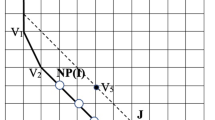Abstract
An important problem in combinatorial noncommutative algebra is to give an asymptotic characterization the growth functions of finitely generated algebras (equivalently, semigroups, or hereditary languages). The growth function of every finitely generated, infinite-dimensional algebra is increasing and submultiplicative. The question of to what extent these natural necessary conditions are also sufficient—and in particular, whether they are sufficient at least for sufficiently rapid functions—was posed and studied by various authors and has attracted a flurry of research. While every increasing and submultiplicative function is realizable as a growth function up to a linear error term, we show that there exist arbitrarily rapid increasing submultiplicative functions which are not equivalent to the growth of any algebra, thus resolving the aforementioned problem and settling a question posed by Zelmanov (and repeated by Alahmadi–Alsulami–Jain–Zelmanov). These can be interpreted as ‘holes’ in the space of growth functions, accumulating to exponential functions in the order topology. We show that there exist monomial algebras and hereditary languages whose growth functions encode the existence of non-prolongable words, and algebras whose growth functions encode the existence of nilpotent ideals (in the graded case). This negatively solves another conjecture of Alahmadi–Alsulami–Jain–Zelmanov in the graded case.

Similar content being viewed by others
Notes
Here \(\alpha =\log 2/\log \eta \approx 0.7674\), where \(\eta \) is the positive root of \(X^3-X^2-2X-4\). ‘Uniformly faster’ here means that \(f(2n)\le f(n)^2\le f(\eta n)\) for \(n\gg 1\).
Even though it is a priori possible that any sufficiently rapid, increasing and submultiplicative function is equivalent to a function which additionally satisfies \(f'(n)\ge n+1\).
The growth of any algebra is equivalent to the growth of some graded algebra; it is potentially possible, however, that a function is equivalent to the growth of a primitive algebra, but not equivalent to the growth of any primitive graded algebra.
In the more general setting of dynamical systems, transitivity may refer to having any non-empty open subset intersect any other non-empty open subset, after a suitable shift.
References
Alahmadi, A., Alsulami, H., Jain, S.K., Zelmanov, E.: On matrix wreath products of algebras. Electron. Res. Announc. Math. Sci. 24, 78–86 (2017)
Bartholdi, L., Erschler, A.: Groups of given intermediate word growth. Ann. Inst. Fourier (Grenoble) 64(5), 2003–2036 (2014)
Bell, J.P.: On the importance of being primitive. Revista Colombiana de Matemáticas 53, 87–112 (2019)
Bell, J.P., Zelmanov, E.: On the growth of algebras, semigroups, and hereditary languages. Invent. Math. 224, 683–697 (2021)
Belov, A.Y., Borisenko, V.V., Latyshev, N.: Monomial Algebras. J. Math. Sci. 87(3), 3463–3575 (1997)
Bergman, G.M.: A Note on Growth Functions of Algebras and Semigroups, Mimeographed Notes. University of California, Berkeley (1978)
Ferenczi, S.: Complexity of sequences and dynamical systems. Discret. Math. 206, 145–154 (1999)
Greenfeld, B.: Growth of finitely generated simple Lie algebras. Proc. Amer. Math. Soc. 149, 607–618 (2021)
Greenfeld, B.: Growth of monomial algebras, simple rings and free subalgebras. J. Algebra 489, 427–434 (2017)
Greenfeld, B.: Prime and primitive algebras with prescribed growth types. Israel J. Math. 220, 161–174 (2017)
Grigorchuk, R.I.: On growth in group theory. In Proceedings of the International Congress of Mathematicians, Vol. I, II (Kyoto, 1990), pp. 325–338, Tokyo, 1991. Math. Soc. Japan
Grigorchuk, R.I.: On the Hilbert-Poincaré series of graded algebras that are associated with groups. Mat. Sb. 180(2), 207–225 (1989)
Grigorchuk, R.I., Pak, I.: Groups of intermediate growth: an introduction. Enseign. Math. 54(3–4), 251–272 (2008)
Kaplansky, I.: Rings with a polynomial identity. Bull. Am. Math. Soc. 54, 575–580 (1948)
Kassabov, M., Pak, I.: Groups of oscillating intermediate growth. Ann. Math. 177(3), 1113–1145 (2013)
Krause, G., Lenagan, T.: Growth of Algebras and the Gelfand-kirillov Dimension (Revised Edition), Graduate Studies in Mathematics, vol. 22. AMS Providence, Rhode Island (2000)
Lubotzky, A., Mann, A.: Residually finite groups of finite rank. Math. Proc. Cambridge Philos. Soc. 106(3), 385–388 (1989)
Morse, M., Hedlund, G.A.: Symbolic dynamics II. Sturmian trajectories. Am. J. Math. 62, 1–42 (1940)
Nekrashevych, V.: Growth of étale groupoids and simple algebras. Int. J. Alg. Comp. 26(2), 375–397 (2016)
Nekrashevych, V.: Palindromic subshifts and simple periodic groups of intermediate growth. Ann. Math. 187, 667–719 (2018)
Petrogradsky, V.: Nil restricted Lie algebras of oscillating intermediate growth. J. Algebra 588, 349–407 (2021)
Shalom, Y., Tao, T.: A finitary version of Gromov’s polynomial growth theorem. GAFA 20, 1502–1547 (2010)
Small, L.W., Stafford, J.T., Warfield, R.: Affine algebras of Gelfand Kirillov dimension one are PI. Math. Proc. Cambridge Phil. Soc. 97, 407–414 (1984)
Smoktunowicz, A.: Growth, entropy and commutativity of algebras satisfying prescribed relations. Selecta Math. 20, 1197–1212 (2014)
Smoktunowicz, A., Bartholdi, L.: Images of Golod–Shafarevich algebras with small growth. Q. J. Math. 65(2), 421–438 (2014)
Steinberg, B.: Simplicity, primitivity and semiprimitivity of étale groupoid algebras with applications to inverse semigroup algebras. J. Pure Appl. Algebra 220(3), 1035–1054 (2016)
Trofimov, V.I.: The growth functions of finitely generated semigroups. Semigroup Forum 21(4), 351–360 (1980)
Zelmanov, E.: A Lecture in the Conference ‘Groups, Rings and the Yang-Baxter equation’held in Spa, Belgium in (2017)
Zelmanov, E.: Private Communication
Acknowledgements
The author thanks Jason Bell and Efim Zelmanov for related inspiring discussions and Guy Blachar for helpful suggestions regarding the paper. The author is thankful to the referee for their careful reading of the paper and useful comments.
Author information
Authors and Affiliations
Corresponding author
Additional information
Publisher's Note
Springer Nature remains neutral with regard to jurisdictional claims in published maps and institutional affiliations.
Rights and permissions
Springer Nature or its licensor (e.g. a society or other partner) holds exclusive rights to this article under a publishing agreement with the author(s) or other rightsholder(s); author self-archiving of the accepted manuscript version of this article is solely governed by the terms of such publishing agreement and applicable law.
About this article
Cite this article
Greenfeld, B. Gaps and approximations in the space of growth functions. Sel. Math. New Ser. 29, 62 (2023). https://doi.org/10.1007/s00029-023-00862-x
Accepted:
Published:
DOI: https://doi.org/10.1007/s00029-023-00862-x
Keywords
- Growth of algebras
- Growth of semigroups
- Hereditary languages
- Complexity of infinite words
- Prolongable languages
- Graded algebras



